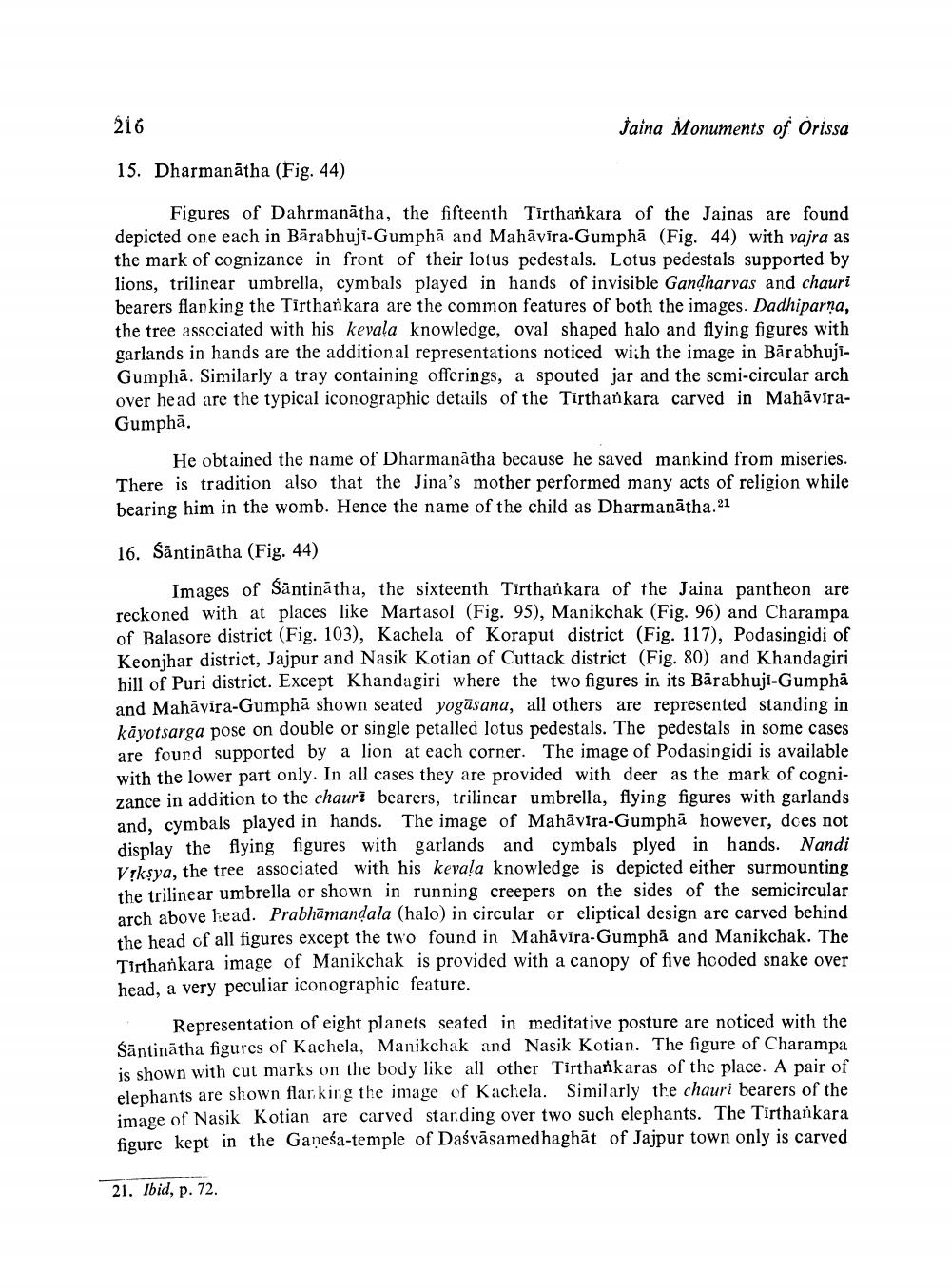________________
216
15. Dharmanatha (Fig. 44)
Figures of Dahrmanatha, the fifteenth Tirthankara of the Jainas are found depicted one each in Bärabhuji-Gumphâ and Mahavira-Gumpha (Fig. 44) with vajra as the mark of cognizance in front of their lotus pedestals. Lotus pedestals supported by lions, trilinear umbrella, cymbals played in hands of invisible Gandharvas and chauri bearers flanking the Tirthankara are the common features of both the images. Dadhiparṇa, the tree associated with his kevala knowledge, oval shaped halo and flying figures with garlands in hands are the additional representations noticed with the image in BarabhujiGumpha. Similarly a tray containing offerings, a spouted jar and the semi-circular arch over head are the typical iconographic details of the Tirthankara carved in MahaviraGumpha.
Jaina Monuments of Orissa
He obtained the name of Dharmanatha because he saved mankind from miseries. There is tradition also that the Jina's mother performed many acts of religion while bearing him in the womb. Hence the name of the child as Dharmanatha.21
16. Santinatha (Fig. 44)
Images of Santinätha, the sixteenth Tirthankara of the Jaina pantheon are reckoned with at places like Martasol (Fig. 95), Manikchak (Fig. 96) and Charampa of Balasore district (Fig. 103), Kachela of Koraput district (Fig. 117), Podasingidi of Keonjhar district, Jajpur and Nasik Kotian of Cuttack district (Fig. 80) and Khandagiri hill of Puri district. Except Khandagiri where the two figures in its Bārabhuji-Gumphā and Mahavira-Gumphã shown seated yogasana, all others are represented standing in kayotsarga pose on double or single petalled lotus pedestals. The pedestals in some cases are found supported by a lion at each corner. The image of Podasingidi is available. with the lower part only. In all cases they are provided with deer as the mark of cognizance in addition to the chauri bearers, trilinear umbrella, flying figures with garlands and, cymbals played in hands. The image of Mahavira-Gumphã however, does not display the flying figures with garlands and cymbals plyed in hands. Nandi Vrkaya, the tree associated with his kevala knowledge is depicted either surmounting the trilinear umbrella or shown in running creepers on the sides of the semicircular arch above head. Prabhamandala (halo) in circular or eliptical design are carved behind. the head of all figures except the two found in Mahavira-Gumpha and Manikchak. The Tirthankara image of Manikchak is provided with a canopy of five hooded snake over head, a very peculiar iconographic feature.
Representation of eight planets seated in meditative posture are noticed with the Santinatha figures of Kachela, Manikchak and Nasik Kotian. The figure of Charampa is shown with cut marks on the body like all other Tirthankaras of the place. A pair of elephants are shown flanking the image of Kachela. Similarly the chauri bearers of the image of Nasik Kotian are carved starding over two such elephants. The Tirthankara figure kept in the Gaṇeśa-temple of Daśvāsamedhaghat of Jajpur town only is carved
21. Ibid, p. 72.




